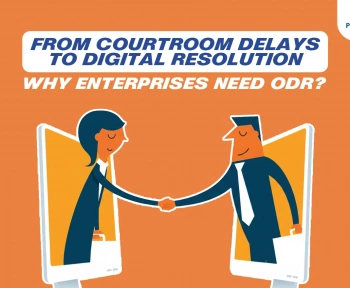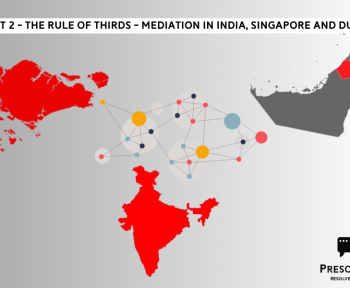PART 3- Mediation in India, Singapore and Dubai – cultural and historical factors:
Mediation is known to be a method of resolving disputes through facilitated negotiation. This symbiotic process has evolved uniquely across different regions. This evolution has greatly been reflected in local traditions, legal developments, and socio-economic changes. While the core principle of mediation of promoting peaceful conflict resolution remains consistent, its trajectory and practice have been largely influenced by historical and cultural factors. This article reflects on some of those factors.
India:
India’s mediation practices are deeply rooted in its ancient traditions. Community leaders and village elders played a crucial role in resolving disputes of the people. The Hindu scriptures of Mahabharata revolve around the Kurukshetra war between the Pandavas and the Kauravas, where Lord Krishna took up the role of mediator. He attempted to prevent the war by offering alternative solutions and encouraging a conversation between the disputing parties. His role as a mediator showed the importance of having peaceful negotiations and mediation even in times of great conflict.
During the Mughal era, the Mughal courts, known as “Adalats,” used mediation techniques to settle disputes, specifically in matters of land and property. The practice of negotiation between disputing parties was encouraged in these courts. The Emperor Akbar depended upon his minister, Birbal who often functioned as a Mediator of disputes. An illustration of Birbal’s skills as a proficient Mediator, is that of the incident where two women claimed to be the mother of a child. The mediator proposed splitting the child in half and giving one half to each woman. Whilst the illegitimate mother consented to the divide, the biological mother renounced her claim to save the child’s life. Ultimately, the biological mother was given custody of the child. This is an example of interest-based negotiation, in which the impartial third party tries to ascertain the parties’ fundamental needs and concerns.
In ancient India, the king of the village often resolved the disputes of his Praja (the public). The king was considered as a God for his ability to resolve disputes adeptly. A common village panchayat, or a group of wise men, who could intervene and mediate conflicts and/or make decisions used to mediate disputes of the public. The Panchayat Raj system in India was also instrumental in establishing dispute resolution systems in ancient India. The Mediators had a good understanding of social, legal, moral, and religious factors prevailing in the land. This conflict settlement technique functioned as a viable resolution for the villages before it became part of the local governance of the land. The Panchayat system relied on culture, norms, religion, beliefs, and habits to resolve conflicts. Typically, a Sarpanch (village leader) is appointed from amongst the village elders. The role of a Sarpanch is to resolve disputes and act as a neutral third party, much like that of a Mediator.
In India, Mediation has been a mechanism that is used in families right from trivial to significant disputes and it can be said that patriarchy has influenced its practice to a large extent. Families during a quarrel seek advice from the eldest male family member. The conflict is then resolved by the assistance of this neutral third party. There are many common factors and the differences between the approaches of each country. Mediation is deeply embedded in cultural, social and historical concepts that may provide an understanding to how the region approaches conflict resolution and management.
Singapore:
Singapore’s mediation practice has evolved from its traditional roots into a sophisticated, formalized system. Historically, mediation was conducted through community-based methods.
Mediation in Asian culture has evolved based on the philosophy of Confucius, a Chinese philosopher, which embraces virtues of benevolence, righteousness, propriety, wisdom, and fidelity. The fundamental attribute of the concept of conflict resolution is to ‘save face’ i.e. the dignity, honour and public image of the other person in order to save yours. The Asian conflict resolution system is based on the following principles of ‘Confucianism’ and ‘Collectivism’. Confucianism is concerned with virtue, morality and respect for the community and its values. ‘Collectivism’ values culture and prioritises the needs and goals of the group as a whole over the needs and desires of each individual. Qualities like interdependence, unity, and selflessness are required to achieve the same.
‘Face concern’, is a Chinese notion that involves individuals’ desire to enhance, maintain, and avoid losing face in their interactions. Deeply influenced by Confucianism, Chinese culture places great importance on “saving face.” In this context, the face signifies not only an individual’s reputation but also that of their family, friends, and colleagues. This concern is a prominent feature of social behaviour in China and serves as a foundational element of Asian collectivism, which emphasises interdependence within groups. In collectivist societies, an individual’s face significantly impacts the group’s reputation. This leads to strong in-group loyalty and various strategies for face preservation in relationships. Consequently, collectivism strengthens the significance of face concern among individuals in these cultures.
‘Face concern’ in Chinese culture has two components: ‘Mian Zi’, which is an external social image and ‘Lian’ which is an internal notion of an individual’s status. In mediation, face concerns arise in respect of the disputant’s image in the other party’s eyes, but also the image that has been perceived before the mediator.
Further, mediation between disputing parties was practised using the culturally backed concept of ‘Main Zi’ which means “face” and ‘Guan Xi’ which means “connection/relationship”. Here the perception that people hold of you and the respect that you command from them is of importance. One can easily ‘lose face’ through the actions of others. Guan Xi can only work if there is a strong network and deep relationships between people. A significant amount of belief is placed in fostering meaningful long-term relationships. The basis of these relationships is knowing one’s place in the hierarchy.
Dubai:
Dubai’s history of mediation is characterized by a unique combination of traditional methods and swift modernization. Originally, disputes were settled by local tribal leaders and through community-oriented methods. Mediation has long been a practice in the Middle East and its origins are rooted in Arabic and Islamic traditions, which emphasize the importance of involving a neutral third party to resolve conflicts.
For centuries, practices like ‘musalaha’ (reconciliation) and ‘sulh’ (settlement) have been integral to conflict resolution in the region. These indigenous methods originated in tribal and village settings, where the ‘sulh’ ritual acknowledges that unresolved grievances can worsen and escalate. In the harsh desert environment, tribes recognized that ‘sulh’ offered a more effective way to break the cycle of revenge and vengeance. This involved a process where tribes would compensate each other for material and human losses. The tribe that suffered less would provide compensation to the tribe that experienced greater losses, fostering a structured approach to conflict resolution. A key aspect of this practice is the agreement between disputing parties to move beyond their differences and establish amicable relations.
Decision-making within families in the Middle East is heavily influenced by patriarchal structures, with the father’s (or the eldest male family member’s) authority being central. The ‘Zaim’, or family leader, plays a critical role in managing conflicts within the family and between families. He acts as a referee, ensuring solidarity and support among family members. In villages, the heads of families, or ‘zuama’, come together to form a council that guides communal decision-making.
These mediation practices are underpinned by mutual understanding and communal regulations, with Sharia law also recognizing the role of an unbiased mediator in resolving disputes. A historical example is that of the selection of Prophet Muhammad as a mediator during the Ka’ba reconstruction, where he proposed a solution that addressed the interests of both parties involved. The roots of mediation in the Middle East can even be traced back to the Mesopotamian civilization, where the ‘Mashkim’ would hear cases before they reached court and assist parties in resolving their disagreements, resembling the role of a modern mediator.
In the Gulf region, the mediation process is closely tied to monarchical governance, characterized by centralized decision-making. This structure has fostered stability and consistency, which in turn helps build trust among the parties involved in mediation. Overall, the blend of traditional practices with modern influences creates a dynamic landscape for conflict resolution in Dubai and the broader Middle Eastern context.
Conclusion:
In conclusion, mediation serves as a vital mechanism for resolving disputes, shaped by the rich historical, cultural, and social contexts of various regions. From India’s ancient practices, where community leaders and religious texts influenced negotiation styles, to Singapore’s evolution which is grounded in Confucian principles and collectivism, the essence of mediation remains rooted in fostering understanding and cooperation. Dubai exemplifies a unique blend of traditional and modern mediation practices, emphasizing the importance of community involvement and the role of neutral third parties in conflict resolution. Across these diverse landscapes, the fundamental goal of mediation—to promote peaceful and constructive dialogue—remains constant. The interplay of historical traditions, societal norms, and evolving legal frameworks highlights how mediation adapts to the needs of different cultures. As we look toward the future, the continued integration of these principles into formal systems can enhance conflict resolution strategies, fostering not only individual relationships but also communal harmony. By appreciating the nuances of mediation across cultures, we can better understand its universal relevance and potential to bridge divides in an increasingly interconnected world.




